Revered poet and artist Ashley Bryan was awarded a 2017 Newbery Honor, a Coretta Scott King Author Honor, and a Coretta Scott King Illustrator Honor for his book in verse Freedom Over Me: Eleven Slaves, Their Lives and Dreams Brought to Life by Ashley Bryan. The celebrated author/illustrator once said, “If you don’t hear a poem spoken, it’s like never hearing a song sung.” The books included in this review are certainly poems that beg to be spoken.
Ages 4–8
A Song About Myself. John Keats. Ill. Chris Raschka. 2017. Candlewick.
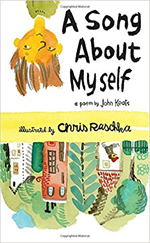 Caldecott Medal and Honor winner Chris Raschka brings a playful poem by John Keats to life with his vibrant watercolor paintings. While visiting Scotland at the age of 22, Keats wrote “A Song About Myself” in a letter to his younger sister. In an illustrator’s note, Raschka shares that this delightful poem reveals Keats to be “a loving brother, who wanted to make his sister laugh with a funny little rhyme.”
Caldecott Medal and Honor winner Chris Raschka brings a playful poem by John Keats to life with his vibrant watercolor paintings. While visiting Scotland at the age of 22, Keats wrote “A Song About Myself” in a letter to his younger sister. In an illustrator’s note, Raschka shares that this delightful poem reveals Keats to be “a loving brother, who wanted to make his sister laugh with a funny little rhyme.”
—LDP
Steppin’ Out: Jaunty Rhymes for Playful Times. Lin Oliver. Ill. Tomie dePaola. 2017. Nancy Paulsen/Penguin.
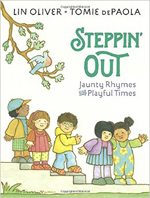 Toddlers can find the mundane amazing and the ordinary an adventure, and Lin Oliver conveys their sense of wonder in this collection of poems. These 19 rhyming poems employ different rhythms sure to hold the attention of little ones and the adults who read to them. The “day” (and book) begins with the couplet “When I open my front door, / There’s a whole world to explore” and ends with the lines “Every day is full of fun, / And tomorrow is another one.” Throughout the day, young children go to the library, the car wash, the mall, and the beach. They experience pancakes with dad, a family barbecue, a first haircut, and unexpected treasures on a walk. Tomie dePaola’s signature style is evident in the faces of the multicultural cast of children in the illustrations.
Toddlers can find the mundane amazing and the ordinary an adventure, and Lin Oliver conveys their sense of wonder in this collection of poems. These 19 rhyming poems employ different rhythms sure to hold the attention of little ones and the adults who read to them. The “day” (and book) begins with the couplet “When I open my front door, / There’s a whole world to explore” and ends with the lines “Every day is full of fun, / And tomorrow is another one.” Throughout the day, young children go to the library, the car wash, the mall, and the beach. They experience pancakes with dad, a family barbecue, a first haircut, and unexpected treasures on a walk. Tomie dePaola’s signature style is evident in the faces of the multicultural cast of children in the illustrations.
—LTP
Fresh-Picked Poetry: A Day at the Farmers’ Market. Michelle Schaub. Ill. Amy Huntington. 2017. Charlesbridge.
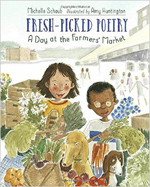 In Fresh-Picked Poetry, two friends and their rambunctious canine companions spend a day at an urban farmers’ market. The delights of the market, and the poems that describe them, include not only fresh produce but also lemonade, honey, free-range eggs, and baked goods as well as musicians, a knife sharpener, and face painter. The illustrations extend the poems with additional story lines and feature a multicultural cast of farmers and shoppers. “Wild Dreams in Two Voices” offers an excellent opportunity to involve young readers in spoken poetry. The book ends with an author’s note, “Fresh Picked Reasons to Spend a Day at the Market,” enumerating the benefits of fresh, local produce.
In Fresh-Picked Poetry, two friends and their rambunctious canine companions spend a day at an urban farmers’ market. The delights of the market, and the poems that describe them, include not only fresh produce but also lemonade, honey, free-range eggs, and baked goods as well as musicians, a knife sharpener, and face painter. The illustrations extend the poems with additional story lines and feature a multicultural cast of farmers and shoppers. “Wild Dreams in Two Voices” offers an excellent opportunity to involve young readers in spoken poetry. The book ends with an author’s note, “Fresh Picked Reasons to Spend a Day at the Market,” enumerating the benefits of fresh, local produce.
—LTP
Round. Joyce Sidman. Ill. Taeeun Yoo. 2017. Houghton Mifflin Harcourt.
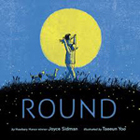 A young child shares her love of round things by taking the reader on a tour of all that is round in the natural world. Newbery Honor-winning poet Joyce Sidman explains why so many things in nature are round. Round is cozy and sturdy; it spreads out and rolls; it is balanced and beautiful. Yoo’s mixed media illustrations are made with printed texture, lending a whimsical quality to the book.
A young child shares her love of round things by taking the reader on a tour of all that is round in the natural world. Newbery Honor-winning poet Joyce Sidman explains why so many things in nature are round. Round is cozy and sturdy; it spreads out and rolls; it is balanced and beautiful. Yoo’s mixed media illustrations are made with printed texture, lending a whimsical quality to the book.
—LDP
Thunder Underground. Jane Yolen. Ill. Josée Masse. 2017. WordSong/Highlights.
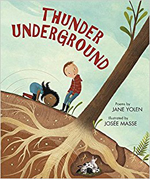 The prolific Jane Yolen celebrates the wonders secreted underground and the “beating heart of the earth” in this collection of poems that are meant to be savored. The first poem explores a house basement; others explore the sounds corn makes as it grows, the sounds animals and insects contribute, geologic forms such as lava and tectonic plates, and man-made wonders such as subways and sewers and lost cities. Masse’s illustrations complement the poems with a pair of young children exploring underground. Yolen begins the book with “UNDER—ground” and ends with “UNDER—stood” to effectively bringing readers full circle in a quest to learn more about what exists unseen beneath our feet. The book closes with “Notes on the Poems: Both Scientific and Personal.”
The prolific Jane Yolen celebrates the wonders secreted underground and the “beating heart of the earth” in this collection of poems that are meant to be savored. The first poem explores a house basement; others explore the sounds corn makes as it grows, the sounds animals and insects contribute, geologic forms such as lava and tectonic plates, and man-made wonders such as subways and sewers and lost cities. Masse’s illustrations complement the poems with a pair of young children exploring underground. Yolen begins the book with “UNDER—ground” and ends with “UNDER—stood” to effectively bringing readers full circle in a quest to learn more about what exists unseen beneath our feet. The book closes with “Notes on the Poems: Both Scientific and Personal.”
—LTP
Ages 9–11
Bravo! Poems About Amazing Hispanics. Margarita Engle. Ill. Rafael López. 2017. Henry Holt.
 The author and the illustrator of the multiaward-winning Drum Dream Girl (2015) are back with a stunning tribute to “Amazing Hispanics.” Engle states these biographical poems are “about a variety of amazing people who lived in geographic regions now included in the modern United States.” Organized chronologically, the poems celebrate those who are known, little known, and unknown from Juan DeMiralles (1713–1780) to Thomás Rivera (1935–1984): healers, activists, scientists, pilots, and chefs. López makes full use of a palette rich in yellows, reds, and oranges to create expressive, full-page portraits of each featured person. Alongside each poem, he provides a smaller illustration symbolizing the person’s area of achievement. Engle provides brief but highly informative notes about each person’s life as back matter. A Spanish-language edition, ¡Bravo! Poemas sobre hispanos extraordinarios (2017), is also available.
The author and the illustrator of the multiaward-winning Drum Dream Girl (2015) are back with a stunning tribute to “Amazing Hispanics.” Engle states these biographical poems are “about a variety of amazing people who lived in geographic regions now included in the modern United States.” Organized chronologically, the poems celebrate those who are known, little known, and unknown from Juan DeMiralles (1713–1780) to Thomás Rivera (1935–1984): healers, activists, scientists, pilots, and chefs. López makes full use of a palette rich in yellows, reds, and oranges to create expressive, full-page portraits of each featured person. Alongside each poem, he provides a smaller illustration symbolizing the person’s area of achievement. Engle provides brief but highly informative notes about each person’s life as back matter. A Spanish-language edition, ¡Bravo! Poemas sobre hispanos extraordinarios (2017), is also available.
—LTP
Feel the Beat: Dance Poems That Zing From Salsa to Swing. Marilyn Singer. Ill. Kristi Valiant. 2017. Dial/Penguin.
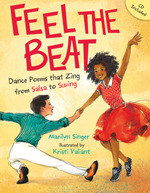 This new offering by Marilyn Singer definitely zings! Our journey through the world of dance begins with complementary poems “All Over the World, Dancing Is Joy” and “Joy Is Dancing All Over the World.” Many of the poems encourage young readers to join in as they see children in the poems overcome self-consciousness and feet that “feel like hooves” to join family and community members to “glow—star of the show.” The poems mimic the rhythms of dances as diverse as hip-hop, square dance, the hora, and the two-step, while the illustrations reflect the diversity of these dances and the people who enjoy them. Valiant’s bold palette is particularly stunning in her illustration for the Bhangra. It is visually obvious that characters in the poems “feel the beat.” A CD (which was not available for review) accompanies the book, and a “Notes About the Dances” is included.
This new offering by Marilyn Singer definitely zings! Our journey through the world of dance begins with complementary poems “All Over the World, Dancing Is Joy” and “Joy Is Dancing All Over the World.” Many of the poems encourage young readers to join in as they see children in the poems overcome self-consciousness and feet that “feel like hooves” to join family and community members to “glow—star of the show.” The poems mimic the rhythms of dances as diverse as hip-hop, square dance, the hora, and the two-step, while the illustrations reflect the diversity of these dances and the people who enjoy them. Valiant’s bold palette is particularly stunning in her illustration for the Bhangra. It is visually obvious that characters in the poems “feel the beat.” A CD (which was not available for review) accompanies the book, and a “Notes About the Dances” is included.
—LTP
Ages 12–14
Out of Wonder: Poems Celebrating Poets. Kwame Alexander (with Chris Colderley & Marjory Wentworth). Ill. Ekua Holmes. 2017. Candlewick.
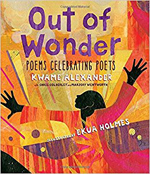 The title of this “lyrical homage to 20 famed poets” was inspired by Lucille Clifton’s quote, “Poetry comes out of wonder, not out of knowing.” The featured poets range from Robert Frost and Gwendolyn Brooks to Okot p’Bitek and Rumi. In “Part I: Got Style,” the authors recreate poems in the styles of the featured poets. “Part II: In Your Shoes” shows the poets’ influences on the authors’ own writings. In “Part III: Thank You,” the authors speak back to those whose work has spoken to them in a “highly personal way.” The book ends with highly readable notes about each famous poet. Ekua Holmes, award-winning illustrator of Carole Boston Weatherford’s Voice of Freedom: Fannie Lou Hamer, Spirit of the Civil Rights Movement (2015), creates mixed media art that is as evocative as the poems they complement and that demand we look as deeply into them as we do the poems.
The title of this “lyrical homage to 20 famed poets” was inspired by Lucille Clifton’s quote, “Poetry comes out of wonder, not out of knowing.” The featured poets range from Robert Frost and Gwendolyn Brooks to Okot p’Bitek and Rumi. In “Part I: Got Style,” the authors recreate poems in the styles of the featured poets. “Part II: In Your Shoes” shows the poets’ influences on the authors’ own writings. In “Part III: Thank You,” the authors speak back to those whose work has spoken to them in a “highly personal way.” The book ends with highly readable notes about each famous poet. Ekua Holmes, award-winning illustrator of Carole Boston Weatherford’s Voice of Freedom: Fannie Lou Hamer, Spirit of the Civil Rights Movement (2015), creates mixed media art that is as evocative as the poems they complement and that demand we look as deeply into them as we do the poems.
—LTP
One Last Word: Wisdom From the Harlem Renaissance. Nikki Grimes. 2017. Bloomsbury.
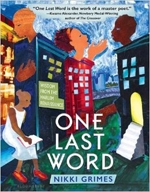 Nikki Grimes’s unique poetry collection is inspired by the poets of the Harlem Renaissance. In the preface to her book, Grimes shares that she wishes to celebrate these poets, add her voice to theirs, and introduce their work to a new generation of readers. Using the Golden Shovel poetic form (explained in an introductory “Poetry Form” note), Grimes writes an original poem in response to poems from master poets such as Langston Hughes and Georgia Douglas Johnson. The book is organized in poetic pairs: a poem from a Harlem Renaissance writer and Grimes’s Golden Shovel poem created with words seeded with a line or stanza of the poem, and sometimes even from the entire poem—quite a creative feat! Background information on the Harlem Renaissance helps situate the poems in their historical context. The powerful poems are paired with artwork by some of today’s most inspiring African American illustrators. Short biographies of the poets and artists are included at the end of the book along with sources and an index.
Nikki Grimes’s unique poetry collection is inspired by the poets of the Harlem Renaissance. In the preface to her book, Grimes shares that she wishes to celebrate these poets, add her voice to theirs, and introduce their work to a new generation of readers. Using the Golden Shovel poetic form (explained in an introductory “Poetry Form” note), Grimes writes an original poem in response to poems from master poets such as Langston Hughes and Georgia Douglas Johnson. The book is organized in poetic pairs: a poem from a Harlem Renaissance writer and Grimes’s Golden Shovel poem created with words seeded with a line or stanza of the poem, and sometimes even from the entire poem—quite a creative feat! Background information on the Harlem Renaissance helps situate the poems in their historical context. The powerful poems are paired with artwork by some of today’s most inspiring African American illustrators. Short biographies of the poets and artists are included at the end of the book along with sources and an index.
—LDP
Ages 15+
Mrs. Nelson's Class. Marilyn Nelson (Ed.). 2017. World Enough Writers.
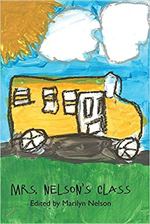 In 1954, the same year that the U.S. Supreme Court ruled that public school segregation was unconstitutional in the landmark case of Brown v. Board of Education of Topeka, Kansas, Marilyn Nelson’s mother became the teacher of a second-grade class of 20 white children near Salina, Kansas. The idea for the book was inspired by a class photo of Johnnie Mitchell Nelson, a young African American teacher, and her students. Marilyn Nelson (winner of the 2017 NCTE Award for Excellence in Poetry for Children) recruited other poets, all of whom are white, to choose a child from the photograph and then write persona poems from their perspective. Marilyn Nelson wrote the poems that represent her mother’s voice. An “About the Authors” section is included at the end of book.
In 1954, the same year that the U.S. Supreme Court ruled that public school segregation was unconstitutional in the landmark case of Brown v. Board of Education of Topeka, Kansas, Marilyn Nelson’s mother became the teacher of a second-grade class of 20 white children near Salina, Kansas. The idea for the book was inspired by a class photo of Johnnie Mitchell Nelson, a young African American teacher, and her students. Marilyn Nelson (winner of the 2017 NCTE Award for Excellence in Poetry for Children) recruited other poets, all of whom are white, to choose a child from the photograph and then write persona poems from their perspective. Marilyn Nelson wrote the poems that represent her mother’s voice. An “About the Authors” section is included at the end of book.
—LDP
For All Ages
Let's Clap, Jump, Sing, & Shout; Dance, Spin, & Turn It Out! Games, Songs, & Stories From an African American Childhood. Patricia McKissack. Ill. Brian Pinkney. 2017. Schwartz & Wade/Random House.
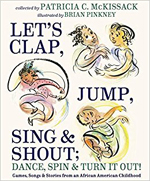 Newbery Honor winner Patricia McKissack has collected her favorite games, songs, poetry, and stories for a new generation of children. Drawing on her own experiences growing up in the American South, McKissack hopes readers will have fun exploring the games she played with her childhood friends. Brian Pinkney, winner of two Caldecott Honors, uses his signature watercolor and ink style to create playful illustrations, adding color and movement throughout the book. In a note from the illustrator, Pinkney shares that creating the art “was pure joy.” Extensive source notes and a bibliography are included.
Newbery Honor winner Patricia McKissack has collected her favorite games, songs, poetry, and stories for a new generation of children. Drawing on her own experiences growing up in the American South, McKissack hopes readers will have fun exploring the games she played with her childhood friends. Brian Pinkney, winner of two Caldecott Honors, uses his signature watercolor and ink style to create playful illustrations, adding color and movement throughout the book. In a note from the illustrator, Pinkney shares that creating the art “was pure joy.” Extensive source notes and a bibliography are included.
—LDP
For Teachers and Librarians
Here We Go: A Poetry Friday Power Book. Sylvia Vardell & Janet Wong. 2017. Pomelo.
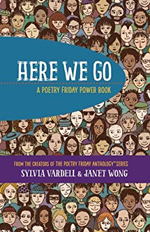 The creators of The Poetry Friday Anthology series have published a new resource for readers interested in discovering the power of poetry. Vardell and Wong collaborated to design an interactive model for reading, writing, thinking about, and responding to poetry. The book is organized into “PowerPack” groups, each of which has an activity, anchor poem, response poem, mentor poem, and a Power2You writing prompt. Many helpful resources are included at the end of the book. Filled with poems by a variety of award-winning poets, this engaging resource invites readers to “power up” and explore the world of poetry.
The creators of The Poetry Friday Anthology series have published a new resource for readers interested in discovering the power of poetry. Vardell and Wong collaborated to design an interactive model for reading, writing, thinking about, and responding to poetry. The book is organized into “PowerPack” groups, each of which has an activity, anchor poem, response poem, mentor poem, and a Power2You writing prompt. Many helpful resources are included at the end of the book. Filled with poems by a variety of award-winning poets, this engaging resource invites readers to “power up” and explore the world of poetry.
—LDP
Nikki Grimes will be at the ILA 2017 Conference & Exhibits as part of the Young Adult Putting Books to Work workshop, which takes place Monday, July 17, from 8:00 a.m. to 10:00 a.m., and the Young Adult Meetup on Saturday, July 15, from 3:00 p.m. to 5:00 p.m.
Kwame Alexander will be at the ILA 2017 Conference & Exhibits as part of the Children’s Choices session “Characters With Character: Using the 2017 Children's Choices Award Winning Reading.”
Linda T. Parsons is an Associate Professor in the Department of Teaching and Learning at The Ohio State University, Marion, where she specializes in middle childhood literacy and young adult literature. Lisa D. Patrick is a Literacy Coach Trainer at The Ohio State University’s Literacy Collaborative where she specializes in children’s literature and early literacy.
These reviews are submitted by members of the International Literacy Association's Children's Literature and Reading Special Interest Group (CL/R SIG) and are published weekly on Literacy Daily.